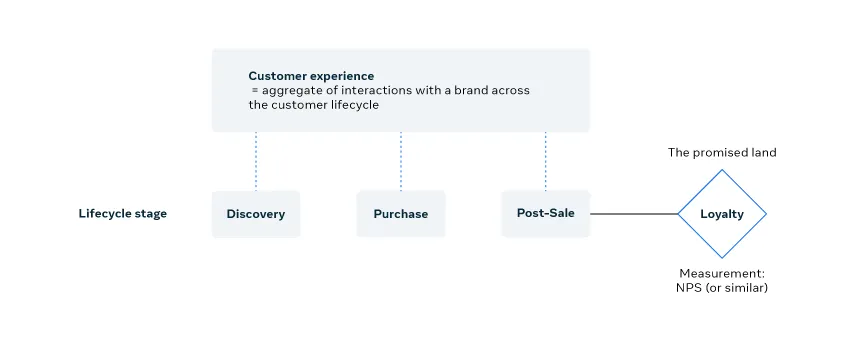Customers
How Business Messaging Could Unlock Loyalty Earlier in the Customer Lifecycle
|
October 7, 2022
Customers
|
October 7, 2022

Customer loyalty can be hard to define and, for many businesses, its impact can be even harder to measure. But when Frederick Reichheld studied the relationship between loyalty and business success via his foundational research, he yielded a simple but compelling takeaway: Businesses that leveraged the power of loyal customers had the potential to unlock tangible cost-savings.
Let’s break down what that really means.
For Reichheld, customer loyalty had the potential to influence a company’s bottom line in a variety of measurable ways. From potentially lowering the cost to acquire new customers (CAC) to right-sizing investment in sales and marketing activities, his research codified the viewpoint that building good relationships with customers is critical to a successful business. As such, Reichheld characterized the value of customer loyalty in practical terms, like cutting costs. His logic was appealingly simple: since long term customers tend to contribute to increasing revenue every year they stay loyal to a company, building relationships with existing customers is more cost effective than attracting new ones.2
Reichheld’s work with Bain turned customer loyalty into a potential lever for driving business growth. But for the concept to become useful, businesses needed a systematic way to measure and manage it. That’s why, in 2003, Reichheld shared his vision for something called the “Net Promoter Score” (NPS). Using NPS, businesses could assess how likely a person was to recommend a company to a friend or colleague.3 By aggregating NPS assessments, businesses were able to identify the number of “net promoters” a business had, as well as opportunities for improvement.
However, for Reichheld, it wasn’t enough to tout the power of customer loyalty in concept only. It had to be accepted and operationalized across an organization in order to be useful, from sales to marketing and beyond. For marketing teams in particular, Reichheld suggested reallocating marketing investments by ranking customer acquisition campaigns on the basis of whether or not they yielded leads that matched the profile of an ideal customer. In 2000, he made the observation about the evolution of customer loyalty in the digital world noting that business leaders in the future would likely be even more reliant on customer loyalty activities to drive business success. “[A]quiring customers on the Internet is enormously expensive, and unless those customers stick around and make lots of repeat purchases over the years, profits will remain elusive,” he said.4 Little did Reichheld know how prescient that statement would be.
Reichheld’s research put customer loyalty on the map for businesses more than twenty years ago. Today, the art and science of cultivating — and capitalizing on — happy customers has evolved into several interrelated customer functions like customer care and customer service, often falling under the broad umbrella of “customer experience”. Gartner defines customer experience or “CX” as any customer perception or related feelings triggered by either the one-off or aggregated effect of “interactions with a supplier's employees, systems, channels or products.” With this definition in mind, we can place customer loyalty activities at the terminus of a desirable customer experience, as shown below.

The loyalty stage is the promised land — ostensibly where businesses want to end up after they’ve done right by their customers across the lifecycle and across functional areas like customer care and service.
The only issue? It takes too much time to get to the loyalty stage. Waiting to evaluate performance at that late juncture could potentially introduce a host of blind spots and missed opportunities along the way.
Within the context of the modern customer lifecycle — which by all accounts is more competitive and more complex than ever before — enterprise businesses can’t afford to wait to engage with the people who could become their most loyal customers. They must have a means of engaging customers much earlier in the journey to loyalty, most notably in the very early days of the journey. This means interacting during discovery and consideration.
Business messaging provides a solution for connecting with customers at every stage of the lifecycle – from discovery beyond purchase. This gives businesses the ability to assess and deploy customer care solutions with potentially more speed and agility than before. What’s more, by leveraging a business messaging solution to support each stage of the customer experience, it’s easier for functional areas within your business to tap into messaging to build a legion of loyal customers.
Deploy touchpoints across digital channels and throughout multi-stage buying processes to capture opt-in to messaging early on. Make care a feature of the discovery stage by serving up answers to common purchase questions and considerations in a low-pressure way.
Show your prospects that messaging is a high-quality and personalized interaction at this stage. Serve up personalized content relevant to their browsing behavior and provide an easy way to reach out to your customer care department via automated chat flows.
Use messaging to share purchase information and show the buyer how to make the most of new goods and services and easily connect with care resources.
Leverage messaging to continue the conversation and ensure customer delight. Send proactive messages to thank customers for their purchase and point them to the resources they ask for in real time.
Use messaging to measure how likely your buyers are to recommend your website, product, or service to others. Incorporate the data into your customer relationship manager (CRM) or other customer experience software.
Reichheld was ahead of his time: His research showed that businesses that leveraged the power of loyal customers had the potential to unlock tangible cost-savings, from sales and marketing activities to retention and beyond. But this was only possible if businesses engaged with their customers regularly and through assessment tools like NPS and other satisfaction KPIs.
In today’s fast-paced and competitive business landscape, however, this may not be enough. In order to drive the success and revenue numbers many companies are after, businesses must abandon end-state measurement of loyalty and start gathering that engagement and feedback much earlier on in the customer lifecycle. Thankfully, the right business messaging solution has the potential to do exactly that, and in ways that complement the activities that make up the modern buyer journey.
Ready to see how messaging can transform your customer care efforts in detail? Click here to learn more.